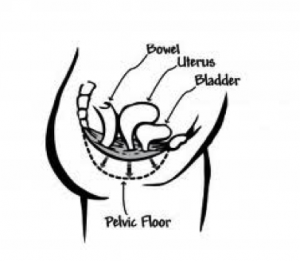It is amazing to feel like you are getting your body back after having a baby! No more maternity clothes (although that elastic band is quite comfy) and regaining your ability to rock that pre-baby wardrobe, or perhaps adding to it…
But getting your body back after baby isn’t only on the superficial layer. It goes much deeper than that.
In honor of Bladder Health Awareness Week, and yup, there is a week for this, I want to talk about REALLY getting your body back.
Studies show that up to 60% of women experience urinary incontinence throughout their lifetime. The number one cause of leakage is childbirth, and more than 4.3 million women give birth in the United States each year. I don’t need to do the exact numbers to show that that is a whole lot of women! This is a problem…a big problem.
Incontinence is defined as an “involuntary loss of urine.” This means any amount of leakage… just because you don’t have to wear a pad doesn’t mean that it’s acceptable. I’m appalled at how many women think that after having a baby, a little bit of leakage when running, or laughing, or when “there’s a really strong urge” is normal. Now don’t get me wrong, those 6 weeks after having your baby are really dedicated to your pelvic floor healing, so there may be some unexpected incontinence. However, after that, you should inform your doctor if you continue to have leakage and be an advocate for yourself to get the help you deserve.
Your pelvic floor muscles are a key player in your core and make up the bottom of the pelvis. These muscles run from your pubic bones back to the tailbone and are responsible for 5 very important functions; 1) control bladder function; 2) control bowel function; 3) allow for appreciation of intercourse; 4) support the pelvic organs; and 5) stabilize the pelvic girdle. That is a lot of responsibility for muscles that are rarely even talked about!!!
Although bringing a baby into this world is a beautiful miracle, it is trauma to your pelvic floor. And like any other muscle that has experienced trauma, these muscles need rehabilitation in order to function properly. I wish I could give the magic formula of how to “work out” your pelvic floor, but everyone is different. Many women don’t even know how to contract these muscles, and more importantly, how to relax them. Luckily, there are women, just like me, who are physical therapists that specialize in pelvic floor muscle treatment and function. Getting a proper evaluation of your pelvic floor is essential in making sure you are participating in the right kind of exercises to regain bladder control.
Until then, here are a few tips to help promote a good, healthy bladder:
- Never push to pee…your pelvic floor should relax to empty your bladder
- Make sure you empty your bladder completely…this may require some deep breathing to help your pelvic floor relax
- Never squat over a toilet to pee…yes, even in public places! Squatting only asks your pelvic floor to work to support you and doesn’t allow you to relax entirely to empty your bladder
- 70% of women with bladder dysfunction also have constipation…get those bowels moving more regularly!!!
- It is normal to urinate 6-8 times in a day, which is once every 2-3 hours…if you are going too much or too little, you are not creating healthy bladder habits
- Don’t J-I-C…in order words, don’t go Just In Case!
- Limit bladder irritants, especially acidic foods/drinks, carbonation and caffeine
- Water is your best friend! The less water you drink, the more concentrated your urine is, and more concentration (aka darker color) can irritate the bladder, causing it to contract more than usual
- Don’t practice your Kegels while urinating—it can be a test to see if you can stop the flow of urine to help you identify your pelvic floor, but you should never make this an exercise, as it interrupts the urine flow and cycle, making bad emptying habits
Victoria Yeisley, DPT, is a physical therapist specializing in pelvic floor muscle dysfunction at One on One Physical Therapy in Atlanta, GA. She has been practicing pelvic therapy exclusively since 2008 and treats urinary incontinence, fecal incontinence, increased urinary urgency/frequency, painful bladder syndrome, pelvic girdle pain, pain with intercourse, diastasis recti, and pre-natal/post-natal musculoskeletal pain. Victoria is extremely passionate about women’s health and especially about the importance of the rehabilitation of the woman’s body while pregnant and after having a baby. Victoria’s personal and professional goal is to increase public health awareness for pelvic floor therapy, especially as it is associated with post-partum care, so that chronic pelvic pain and voiding dysfunction can be prevented. While in Chicago, she assisted with integrating pelvic floor physical therapy into “normal” pregnancy and post-partum care to ensure complete body recovery. It is her desire to continue this advocacy in Atlanta, and at One on One Physical Therapy.








Great read! Incredibly helpful